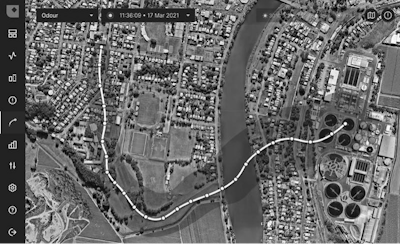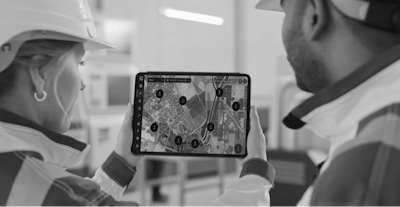With this rapid change comes a world of opportunity, from saving time and money, to improving communication and data collection. Manual processes that were once cumbersome and inefficient can now be implemented at a rapid pace – including traditional environmental monitoring methods.
Most environmental monitoring professionals who can recall the work environment of only 15 years ago will be able to remember - probably not with great fondness - the repetitive and mundane activity that was needed to simply get some real numbers to review.
A lot of resources were sunk into checking and maintaining monitoring equipment, downloading data, and then working through clunky software to put it into reasonable shape.
It was not unusual to find that since the last download, some of the data - or heaven forbid, all of it - was missing or corrupt. There was no way to know this without someone spending time to go to site and intervene manually.
What is the benefit of environmental monitoring software to industrial facilities?
If we fast forward to today, there have been some dramatic advances in environmental monitoring software solutions that are still unfolding. These are changing how we think - or should think - about environmental data. Accurate data is the foundation of all compliance reporting and, ultimately, can support complex decisions at industrial facilities.
Air quality, noise, water quality, odour, dust and vibration have always been notoriously difficult for industrial operators to manage. Pinpointing the cause of the problem and identifying a solution complex, expensive and time-consuming.
Furthermore, variables that influence the significance of these problems – such as weather conditions – are always changing.
At industrial facilities the use of buffer distances is an example of an approach for managing impact that was once effective but is often no longer sufficient.
When using this method, companies that produce significant amounts of noise and vibration, or that are more susceptible to having odour, dust or similar as a by-product of their operations, conduct activities away from nearby urban areas.
However, urban communities have continued to expand over time and gradually move within buffer distances. This means industrial facilities can no longer deliver the level of control the residents and business owners are satisfied with.
This is where accurate and advanced environmental monitoring software, which is typically used for compliance purposes, becomes more valuable. For many facilities, the ability to readily access real-time data is the key to making informed operational decisions that can have a positive impact financially.
While measuring and communicating environmental impact isn’t necessarily easy for companies, it’s incredibly important – especially as our global population continues to grow and new challenges emerge.
Use of environmental monitoring software by operators at industrial facilities can minimise risk, reduce regulatory concerns, improve efficiencies and decrease the impact of their operations on the environment and local towns and cities. This information can be communicated to nearby communities for transparency and maintaining social licence.
The result of this is an improved bottom line and strong transparent relationships with neighbours – which is better not only for businesses and their employees, but also for their relationships with regulators and their communities.
Environmental monitoring software is by no means straightforward, but advanced technology means it’s now accessible to and can be understood by non-experts with greater ease.
Replacing traditional methods with environmental monitoring software
Over the past few years, the advancement of environmental monitoring software has accelerated together with the rapid evolution of technology. Operators can now access rich real-time data, predictive modelling and quality insights to inform decisions at their facility – but this wasn’t always the case.
This level of accurate and widespread data collection has only emerged as an accessible and simple to use option in recent times.
The complex science behind environmental monitoring is now faster and easier to interpret, being represented in user-friendly formats. You no longer need to be an expert in the field to unlock the myriad of operational benefits environmental analytics offer.
If you’ve used traditional environmental monitoring software at one point in time – and have since moved across to more modern versions – you’ll know firsthand just how drastically this technology and industry has changed over the years.
Since environmental monitoring software first emerged, we’ve come a long way. Here’s a look at how it’s changed and where we are today.
1. Incorporating environmental monitoring data into business objectives
If we think about the bytes of usable data returned for each hour of labour spent on traditional environmental monitoring methods, the cost-benefit scorecard was abysmal by today’s standards. Real-time environmental monitoring software has certainly offered a drastic improvement.
In fact, this line of thinking leads us to the time and resources that were, and still are, spent on gathering data: it is quite an investment when it is all added up, and so the data gathered deserves to be treated with respect, even if the story it tells is generally unexciting. There is another story to be told about wasted, lost and abused data over the years that was not valued properly, was lost to time, and this loss ultimately became a handicap to future plans.
Unfortunately, most traditional environmental monitoring software still only focuses on the collection, storage and only sometimes, the display of information. Although useful for reporting on issues that have happened in the past, analysis of data is time consuming and difficult for non-subject matter experts.
‘Environmental intelligence’ platforms offer science-based capabilities to help business unlock data, knowledge and insights from their environmental networks.
The real-time and predictive capabilities available in environmental intelligence platforms today mean that data can be used in ways that were impossible not too long ago. Rather than just feeding a reporting system that looked backwards in time, summarising statistics and highlighting key issues in retrospect - and basically just ticking the licence compliance boxes - environmental data can now also be used to provide operational support, reaching out from the environmental department deep into operations. The trick is not just providing data but giving easily digestible guidance on how to keep moving in the right direction.
Once an environmental intelligence platform is implemented, operators can start using insights to make critical operational decisions confidently and swiftly right away.
Unfolding issues can be identified before and as they arise. Action can be taken before they evolve into chronic issues that only amplify costs.
All of this saves you time and money and means your team can spend less time following up on complaints and more time on meaningful tasks that will benefit your company in the long-term. It also means you are less likely to be hit with hefty penalties, which could have a significant financial impact on your facility.

Environmental intelligence platforms enable users to make confident decisions to minimise risk of compliance breaches and impact on the community.
2. Diagnosing the source of emissions is difficult and time-consuming
When a complaint about odour, air quality or similar is made by the community, it has been notoriously difficult in the past for facilities to determine the source of the issue quickly and effectively.
This once longwinded process can now be completed relatively quickly across various industries, thanks to reverse trajectory meteorological modelling techniques that have been commercialised by environmental intelligence.
Reverse trajectory modelling begins at the complaint location, then uses real-time data and algorithms to work backwards and pinpoint where the issue stems from. With this information, operators can determine whether their facility is the culprit, or if they can refute responsibility with defensible data.
If we consider a wastewater treatment plant for instance, there are still routine examples occurring when a particular facility has been blamed for naturally occurring events. Before modern environmental monitoring data became available, it was more difficult for them to prove whether issues like these were linked to their operations or something else.
When facilities could not confidently determine if a problem was caused by their operations, they may have spent considerable time and money trying to amend non-existent problems with misdirected efforts. This can also be detrimental to their reputation in the community and lead to bad press coverage of their facility.

Reverse trajectory modelling begins at the complaint location, then uses real-time data and algorithms to work backwards and pinpoint where the issue stems from.
3. Information is too complex and difficult to act on
It was once a fact that data collection and reporting was a labour-intensive grind for environmental managers. The process of collecting environmental data and converting it into valuable insights for businesses is extraordinarily complex.
But as technology has evolved, accessing and understanding complex environmental data has become more realistic for operators, even when they do not have specialist knowledge or technical qualifications.
Mistakes are costly when it comes the environment, not only financially but also in reputation and social licence terms. The threat of a costly operational shutdown or legal action due to serious regulatory breaches is indeed a reality.
Environmental monitoring software now caters to experts and non-experts alike who need to make critical decisions based on what’s occurring now and in the future. There’s no need for businesses to get hindered in technical data that’s difficult to draw information from. Technical information can now be displayed in a way that’s easy to comprehend, so you can quickly monitor, manage and report on multiple environmental parameters.
4. Companies need readily available information, but collecting data takes time
Collecting meaningful data takes time, but when an issue arises or there’s a complaint lodged by someone in the community, that’s something companies don’t have.
At these times, having the information you need to make informed and confident decisions readily available is invaluable – and gives you the ability to resolve the problem quickly and maintain strong community relationships.
The data collection process has gotten much faster over the years. Rather than having to wait for the information they need to become accessible, companies can now instantly view and interpret real-time data when making operational decisions.
Environmental monitoring has become so advanced we can now in many cases identify problems before they even happen, which gives companies the insight to proactively make changes ahead of them coming into fruition.
Wastewater treatment plants are one type of facility that stands to particularly benefit from this advancement.
The weather has a major influence on odour emissions. Being able to base operational decisions – such as when to schedule maintenance activities – on local weather and air quality pollutant emission rates and concentration at your site up to 72-hours in advance gives you the information you need to keep operations on track and avoid disruptive problems arising.

Facility operators can use environmental intelligence to act on unfolding air quality and odour issues in real-time to prevent them from becoming bigger problems in the community.
Envirosuite’s proactive environmental management software
Through harnessing the power of modern environmental monitoring software and the actionable insights it provides, operators can make faster, more confident decisions that protect their operations and people.
Envirosuite’s environmental management software is designed to be user-friendly and practical, while still offering unrivalled scientific and technological excellence.
With environmental intelligence available at the click of a button, you can protect the wellbeing of communities and your facility’s reputation.
Access real-time data, local weather forecasts and emissions modelling for a faster and more accurately targeted response to issues.
Maintain positive relationships with communities that neighbour your site by taking swift action to resolve complaints and mitigating problems before they become chronic.
Receive early warning signs of threshold breaches, so you can avoid certain issues altogether. Depending on the environmental monitoring software you use, this could be for air quality, odour, dust or similar.
Refute or confirm responsibility for complaints with defensible data.
Designed for rapid deployment, our monitoring and forecasting solutions can be implemented in as little as a few days. Contact us to talk with our team about the environmental monitoring software we have available.
